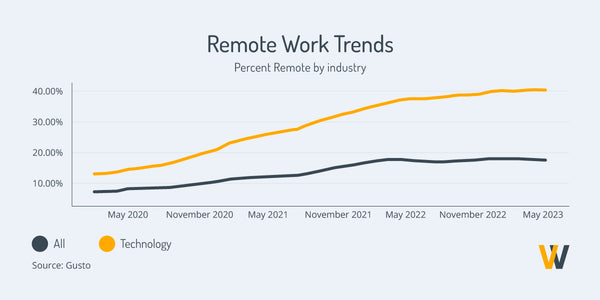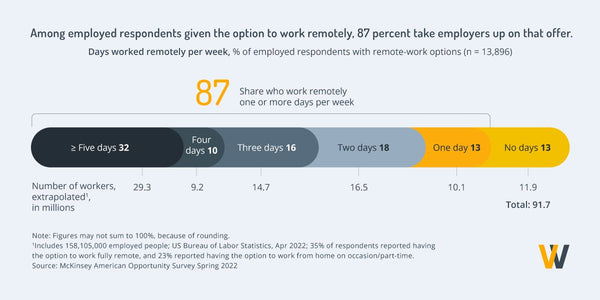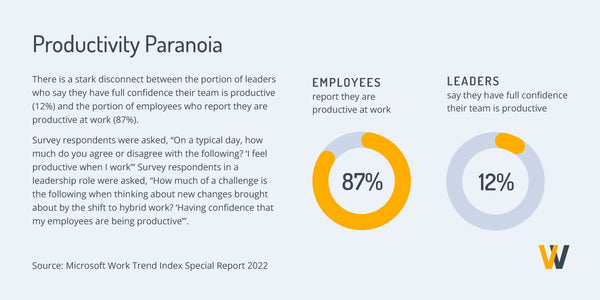The great remote work debate: Who is winning?
 Mara Quintanilla
Mara Quintanilla
In a post-pandemic world, it has been pretty clear that remote work has become a fixture in the corporate landscape. However, the better part of 2023 has seen an intense debate among C-suite executives between allowing working remotely and issuing return-to-office mandates.
The month of June, in particular, was full of editorial pieces either declaring that remote work is dead or that it is taking over the business world. Those against working remotely cite that factors like productivity, collaboration, efficiency, and company culture are taking a hit, while those championing it talk about the improvements to work-life balance, happiness, and focus time.
Let’s take a look at what the data says regarding the state of remote work, the prominent opposing figures to the distributed arrangement, and why, despite criticism, remote work will prevail.
Remote work statistics for 2023 - what does the data tell us?
The ongoing discussion between top executives doesn't seem to have a significant impact on the remote workforce. On the contrary, the trend in flexible arrangements has been steadily going upward.
Overall, remote work statistics point to an increase in distributed company operations that allow each person to decide when and where they work. And there's no sign of stopping this growth.
According to Gusto, before the pandemic struck, in January 2020, an average of 6.6% of American workers in all industries had a completely remote work arrangement. By August 2022, the average had reached 15.3%. This year, in May 2023, the percentage is at 15.8%.

In the Tech industry, the trend was even higher. The number of remote workers averaged 12.9% in January 2020, 36.6% in August 2022, and 40.3% in May 2023.
As for hybrid arrangements, McKinsey reported that 58% of interviewed workers in the United States, equivalent to 92 million people, said they could work remotely at least some days a week. Likewise, 87% of surveyed employees said that they would work remotely if the option was available.

On a global scale, Gartner estimates that by the end of 2023, 48% of knowledge workers in organizations across the world will work in fully remote or hybrid teams (39%).
Additionally, the BBC reported that job postings that explicitly mentioned remote work increased by 319% in the US between January 2022 and March 2022.
Employees’ perception of remote work
Remote work remains a popular work arrangement for employees. For example, in Mckinsey’s study, data shows that 80 million Americans worked remotely some days of the week in 2022, and many would prefer most of the week if they had the chance.
Specifically, 87% of workers said they would spend an average of three days a week working from home.
In Buffer’s State of remote work 2023, 91% of employees reported having a positive experience with remote working, with just 1% stating they had a negative experience, and the rest of them were neutral.
In the same report, flexibility emerged as the biggest benefit of remote work. Remote workers value flexibility in how to manage their time (22%), where they choose to live (19%), and choosing their work location (13%).
The remote work debate: Productivity vs. flexibility
At its core, the debate between remote work and the return to the office seems to be the belief that more flexibility means less productivity. Workers think they are more productive when they have more control over where and when they work, while employers believe the opposite.
In a Fortune article, Dr. Gleb Tsipursky said the forced return to the office (also dubbed RTO) is “the very definition of insanity.” Tsipursky argues that the office is not a magical place that warrants better results. Just because remote workers are herded back to offices, outcomes will not miraculously improve.
Paradoxically, there are different views on the topic depending on who you ask. In Microsoft’s Work Trend Index Special Report from September 2022, 87% of employees said they were productive in managing their work tasks. Meanwhile, only 12% of leaders said they had full confidence that their team was productive after shifting to a hybrid arrangement.

Similarly, Forbes cites a report by Citrix based on a global survey of 900 business leaders and 1,800 knowledge workers found that half of the business leaders believe that when employees are not physically present, they don’t work as hard.
In Tsipursky’s article, he cites research by EY-Parthenon stating that productivity for American workers plunged by 2.7% in the first quarter of 2023 compared to the same period in 2022. This is the fifth consecutive quarter that this indicator has dropped, which had not happened since 1948.
According to Gregory Daco, chief economist at EY-Parthenon, this decline means that employees are working longer hours, but their effort is producing fewer results. This is happening even though the labor market has been resilient and continued job gains have occurred.
Although he states that the flexible work arrangement could cause this decline, other factors include high inflation and labor market churn.
Who is against remote work?
The remote work discussion is not all talk. 14% of Fortune 100 companies issued return-to-office mandates as early as 2021, not without resistance from remote workers.
According to tech.co, as of May 2023, the list of companies that stopped having a distributed workforce includes Dell, Disney, Amazon, Activision Blizzard, Starbucks, Walmart, General Motors, United Parcel Service, and Meta. Even Google has asked remote workers to reconsider switching from full remote to hybrid.
When it comes to top executives of businesses who have spoken against it, the most relevant names include JPMorgan’s lead, Jamie Dimon, OpenAI CEO Sam Altman, IBM’s Arvind Krishna, and Tesla founder Elon Musk.
According to the NY Post, Dimon believes that the people who are out of their seats five days a week make it easier to fire them first. However, insiders say that one reason behind his posture is that a new JP Morgan skyscraper is under construction in Manhattan.
Arvind Krishna, the CEO of IBM, believes that working remotely can be detrimental to a person's career, particularly concerning advancement into managerial roles. While IBM is not currently mandating that remote employees return to the office, Krishna suggests that being a people manager while remote is challenging because it's difficult to supervise individuals effectively without in-person interactions with colleagues.
OpenAI CEO Sam Altman argues that the tech industry's worst mistake was assuming that remote work would be successful indefinitely and that talent and startups could thrive without being together in person. Altman believes technology is not yet advanced enough to develop and facilitate the tools for fully distributed work, particularly for startups.
Many other CEOs, including Bob Iger of Disney, Howard Schultz of Starbucks, and Robert Thomson of News Corp, share these views on management and company culture.
Elon Musk has gone as far as saying that working remotely is a “moral issue.” In his words, “The whole notion of work-from-home is a bit like, you know, the fake Marie Antoinette quote, ‘Let them eat cake.'”
“It’s like, it’s like really? You’re gonna work from home and you’re gonna make everyone else who made your car come work in the factory? You’re gonna make people who make your food that gets delivered – they can’t work from home? The people that come fix your house? They can’t work from home, but you can? Does that seem morally right? That’s messed up,” said the Tesla founder in an interview with CNBC.
“It’s a productivity issue, but it’s also a moral issue,” he said. “People should get off their goddamn moral high horse with this bulls–t because they’re asking everyone else to not work from home while they do. It’s wrong.”
Is remote working a moral issue?
While there is an element of disparity and inequality in what Musk describes, remote work is not inherently at fault. In jobs where the majority of work happens on the internet, it’s not always essential that employees need to be in the same physical locations, unlike manufacturing jobs.
While where work happens can determine the possibility of flexible arrangements, data shows that remote has grown since 2019 in every economic sector, including food preparation businesses (2.5x), farming (1.9x), and factory production (3x), according to an NBER research paper.
The reason even traditional industries are experimenting with flexible work arrangements is that the concept of office work has remained unchanged since the 1950s. Almanac, in their article “The Modern Work Crisis,” describe office work as an assembly line: a manager at any given company looking over the shoulder of his staff members as they type data in a spreadsheet. It is in-person, in real-time, with minimal transparency and a focus on tracking inputs like hours worked.
But after COVID and the massive shift to WFH, people from all walks of life got a taste of working wherever and whenever they liked. Employees working remotely saw they could move closer to family and have flexible schedules that accommodated caregiving or hobbies without impacting collaboration. If they stayed remote, they could access better experiences, salaries, or benefits than in their local market, opening the door for global hiring.
Musk’s approach sounds like an “if not everyone can have it, then no one can” mindset. He places the blame on the remote workforce instead of doing something to promote changes in corporate culture. If such flexible work arrangements put on-site workers at a disadvantage, why not counter with more company benefits? Better health insurance, PTO options, lenient schedules, maternity and paternity licenses, etc., for essential workers.
A similar scenario is like blaming individual actions for climate change when corporations and industrial complexes are at fault for mass contamination and pollution.
In any case, the disparity between those who work from home and those who have to be physically present is as immoral as the gender pay gap. These issues respond to systemic workplace inequalities rather than a person's fault.
Why remote work will prevail
Remote work exposed the cracks of an already failed system among companies. The traditional office was flawed before the arrival of widespread flexible work arrangements. Gender inequality, lack of diversity, employee burnout, poor mental health resources, and lack of work-life balance, for example, were some of the issues plaguing the workplace.
After the shift to remote that the pandemic brought, many employees realized that corporate rules were not always set in stone and change was possible. When managers tried to apply these same corporate rules to remote teams, they quickly found it was impossible to maintain efficiency. So they rush people back to the office to continue the same flawed work practices while blaming remote or calling it a “moral issue.”
Although some CEOs are pushing for a return to the office, companies and employees will likely have to settle on a middle ground like hybrid work. Microsoft’s New Future of Work Report 2022 highlights that employees strongly prefer hybrid work (47% in 2021), with most workers willing to stay home an average of 2.8 days per week as of March 2022.
Meanwhile, employers are increasingly planning for a hybrid future, allowing workers to work from home some days a week. This resulted in a near-doubling in 2021 of US employees who said their employer was planning a hybrid work model, from 16.5% to 28.4%.
With an average of 15.8% of American employees having fully remote work arrangements and 48% of knowledge workers worldwide expected to work fully remotely or in a hybrid arrangement by the end of 2023, it’s safe to say that remote work has become a staple in the global workforce. Remote work makes sense. It isn’t dead and will continue to flourish among companies and organizations that value their employees' well-being.





